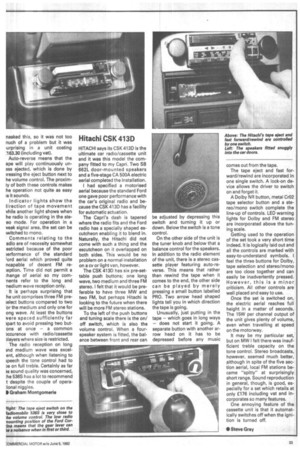Hitachi CSK 413D
Page 31

If you've noticed an error in this article please click here to report it so we can fix it.
HITACHI says its CSK 413D is the ultimate car radio/cassette unit and it was this model the company fitted to my Capri. Two SB 662L door-mounted speakers and a five-stage CA 500A electric aerial completed the installation.
I had specified a motorised aerial because the standard Ford one gave poor performance with the car's original radio and because the CSK 413D has a facility for automatic actuation.
The Capri's dash is tapered where the radio fits and the Ford radio has a specially shaped escutcheon enabling it to blend in. Naturally, the Hitachi did not come with such a thing and the escutcheon on it overlapped on both sides. This would be no problem on a normal installation on a cv or light van, however.
The CSK 413D has six pre-settable push buttons; one long wave, two medium and three FM stereo. I felt that it would be preferable to have three MW and two FM, but perhaps Hitachi is looking to the future when there will be more FM stereo stations.
To the left of the push buttons and tuning scale there is the on/ off switch, which is also the volume control. When a fourspeaker system is fitted, the balance between front and rear can be adjusted by depressing this switch and turning it up or down. Below the switch is a tone control.
On the other side of the unit is the tuner knob and below that a balance control for the speakers. In addition to the radio element of the unit, there is a stereo cassette player featuring auto-reverse. This means that rather than rewind the tape when it comes to the end, the other side can be played by merely pressing a small button labelled PRO. Two arrow head shaped lights tell you in which direction the tape is going.
Unusually, just putting in the tape — which goes in long ways — does not start it going. A separate button with another arrow head on it has to be depressed before any music comes out from the tape.
The tape eject and fast forward/rewind are incorporated in one single switch. A lock-on device allows the driver to switch on and forget it.
A Dolby NR button, metal Cr02 tape selector button and a stereo/mono switch complete the line-up of controls. LED warning lights for Dolby and FM stereo are incorporated above the tuning scale.
Getting used to the operation of the set took a very short time indeed. It is logically laid out and all the controls are marked with easy-to-understand symbols. I feel the three buttons for Dolby, tape selection and stereo/mono are too close together and can easily be inadvertently pressed. However, this is a minor criticism. All other controls are well placed and easy to use.
Once the set is switched on, the electric aerial reaches full height in a matter of seconds. The 15W per channel output of the unit gives plenty of volume, even when travelling at speed on the motorway.
It may be my particular set, but on MW I felt there was insufficient treble capacity on the tone control. Stereo broadcasts, however, seemed much better, although in spite of the five section aerial, local FM stations became "spitty" at surprisingly short range. Sound reproduction in general, though, is good, especially for a set which retails at only £176 including vat and incorporates so many features.
One annoying feature of the cassette unit is that it automatically switches off when the ignition is turned off.
• Steve Gray


























































